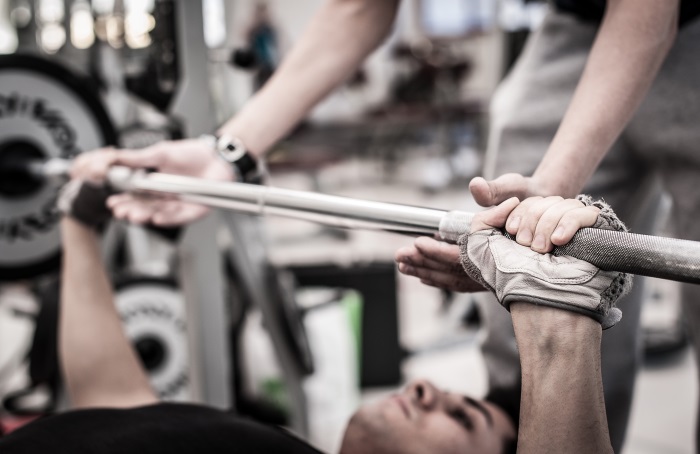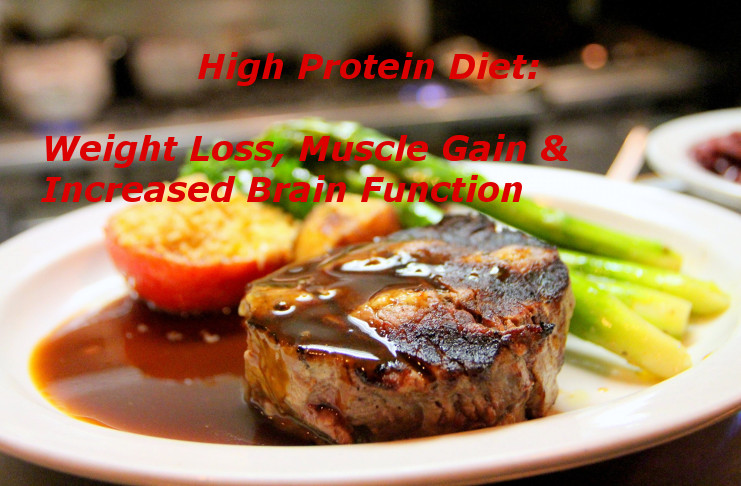There’s an old saying that goes something like:
The foolish man builds his house upon sand, only to have the wind and waves destroy it soon after. The wise man on the other hand, builds a sturdy house upon rock, sure to withstand the elements until long after he’s left this Earth.
Reading in to the analogy above, it should be obvious that it’s important to have a good foundation if you want your house to last. It’s the same when it comes to building strength and muscle. So many of us start out desperate to toss plate after plate on the bar striving to be the biggest, strongest, buffest dude at the gym.
After all, after you become as big and strong as Ronnie Coleman or Branch Warren, the chicks will all be dying to invite you into their beds, and all the pencil-necked little wankers will be staring at you in awe as the olympic bar bends in a big “U” as you hoist the mind-boggling weights over and over again with remarkable ease.
Auxillary Approach for the Win
The auxillary muscle-strengthening workout detailed below will systematically strengthen all the underlying muscles that contribute to strong power lifts, helping you to add up to 100 pounds to your weaker strength lifts this year!
The devil’s in the details with the workout detailed below. You’ll need to follow the order of each exercise as outlined, exactly as outlined. While you’ll recognize many, if not all of them, the key to exhausting and strengthening the auxillary muscles is starting with the exercises that tax them into submission the most, then progressively moving to those which don’t require much stability at all (ie., fixed plane machine movements like the Smith Machine, Hammer Strength, and T-Bar apparatus.) Each workout is made up of circuits using 3 carefully chosen exercises.
This isn’t a Nancy-pants workout guys! Prepare to burn the living hell out of your muscles every time you step up to the bench, rack, machine, etc.
How Auxillary Training Works
Basically, you’ll be doing a 3-day split routine. The first 3 days will be devoted to the auxillary training outlined below: Legs on day 1, Chest and Shoulders on day 2, and Back on Day 3. Gradually raise the weights used once you become comfortable and can complete an entire circuit with little to no rest. After a rest day, you’ll do the same body parts in the same order, but using the lifts you normally do. Mix your arm and calf training in with the major body parts as you normally would, training them once or twice a week, as you prefer. Take extra rest days as needed.
(Note: Move from one exercise to another in each body part sequence with as little rest as possible for best results. Don’t try to be Hercules when you’re first starting this routine. Lower the weight enough that you can get 10 reps in with each exercise, and try to only rest after you’ve completed an entire circuit.)
Day 1: Legs
(Do 10 reps each in a circuit. Try to rest less than a minute after each completed round. Do 3 circuits total for each body part.)
Bulgarian Squat:
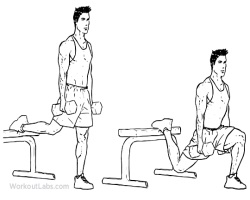 The famed one-legged dumbbell squat made famous by Bulgarian olympic powerlifters seeking to boost their strength between competitions. Stand erect, holding two dumbbells you can do 10 reps with at your sides. Put one leg behind you resting on a bench and squat to parallel with the other leg while keeping your back straight.
The famed one-legged dumbbell squat made famous by Bulgarian olympic powerlifters seeking to boost their strength between competitions. Stand erect, holding two dumbbells you can do 10 reps with at your sides. Put one leg behind you resting on a bench and squat to parallel with the other leg while keeping your back straight.
Squat:
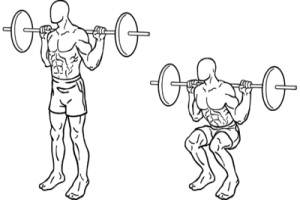 The king of all muscle and strength builders. Get under the bar and rest it on your upper back where your traps and upper back meet. Unrack the weight and set your feet shoulder width apart, with your toes pointed outwards slightly. Squat to parallel at least, lower if you’re able to.
The king of all muscle and strength builders. Get under the bar and rest it on your upper back where your traps and upper back meet. Unrack the weight and set your feet shoulder width apart, with your toes pointed outwards slightly. Squat to parallel at least, lower if you’re able to.
Smith Machine Squat:
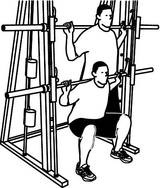 Do these exactly as you did the free weight squats, but only go to parallel. Deep Smith Machine squats are bad juju because the fixed plane of motion will force you to bend forward too much, which will destroy your back. Set a narrow bench or chair under your butt to help keep yourself honest.
Do these exactly as you did the free weight squats, but only go to parallel. Deep Smith Machine squats are bad juju because the fixed plane of motion will force you to bend forward too much, which will destroy your back. Set a narrow bench or chair under your butt to help keep yourself honest.
Day 2: Chest and Shoulders
(Do 10 reps each in a circuit. Try to rest less than a minute after each circuit. Do 3 circuits total.)
Flat Dumbbell Bench (Chest):
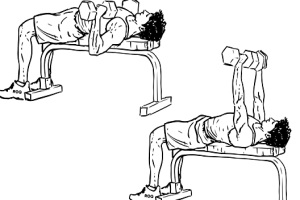 Grab a couple of dumbbells you can easily do 10 reps with and jump on the flat bench. Press the dumbbells from shoulder level and press them up, stopping when they’re an inch away from each other. Don’t rest at the top or bottom of the movement. Also, don’t let your shoulders spread too wide; that’s nothing more than a modified fly and will soon lead to injury with heavier weights.
Grab a couple of dumbbells you can easily do 10 reps with and jump on the flat bench. Press the dumbbells from shoulder level and press them up, stopping when they’re an inch away from each other. Don’t rest at the top or bottom of the movement. Also, don’t let your shoulders spread too wide; that’s nothing more than a modified fly and will soon lead to injury with heavier weights.
Flat Barbell Bench (Chest):
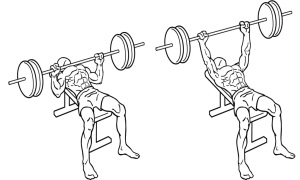 Lie on the bench and grip the bar with your hands slightly shoulder width apart. Keep your elbows tucked in to engage as much chest and front delts as possible, then lower the bar to your nipples. Explode from the bottom and don’t lock your elbows on the positive part of the rep.
Lie on the bench and grip the bar with your hands slightly shoulder width apart. Keep your elbows tucked in to engage as much chest and front delts as possible, then lower the bar to your nipples. Explode from the bottom and don’t lock your elbows on the positive part of the rep.
Smith Machine Bench (Chest):
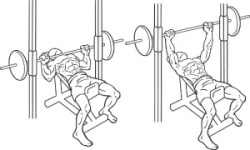 Finish the circuit with Smith Machine presses. You’ll do these the same as the flat bench, but because of the fixed range of motion, aim to lower the bar somewhere around mid-chest.
Finish the circuit with Smith Machine presses. You’ll do these the same as the flat bench, but because of the fixed range of motion, aim to lower the bar somewhere around mid-chest.
Now move on to the shoulder circuit…
Seated Overhead Dumbbell Press (Shoulders):
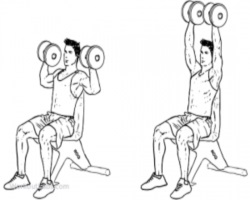 Grab a hold of a couple of dumbbells and kick them up to your shoulders. As with the flat dumbbell presses, don’t let the dumbbells stray too far out to the side. Press up from the shoulders and stop just short of the dumbbells touching over your head. Don’t lock out your elbows at the top or rest at the bottom.
Grab a hold of a couple of dumbbells and kick them up to your shoulders. As with the flat dumbbell presses, don’t let the dumbbells stray too far out to the side. Press up from the shoulders and stop just short of the dumbbells touching over your head. Don’t lock out your elbows at the top or rest at the bottom.
Overhead Barbell Press (Shoulders):
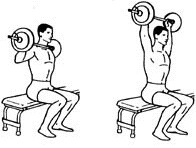 You can do these seated or standing; front (military) or behind the neck. Don’t use your legs to help if standing. Grab the bar at slightly wider than shoulder width and press the bar up and down, without locking out at the top or resting at the bottom.
You can do these seated or standing; front (military) or behind the neck. Don’t use your legs to help if standing. Grab the bar at slightly wider than shoulder width and press the bar up and down, without locking out at the top or resting at the bottom.
Smith/Shoulder Machine Press (Shoulders):
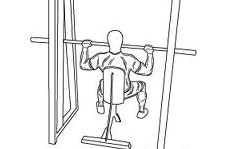 Position yourself under the bar so that you’re not straining your core backwards or forwards too much during the press. Use a Smith Machine, Hammer Strength, or other shoulder pressing machine and perform 10 reps without pausing at the top or bottom of the movement.
Position yourself under the bar so that you’re not straining your core backwards or forwards too much during the press. Use a Smith Machine, Hammer Strength, or other shoulder pressing machine and perform 10 reps without pausing at the top or bottom of the movement.
Day 3: Back
(Do 10 reps each in a circuit. Try to rest less than a minute after each circuit. Do 3 circuits total.)
One Arm Dumbbell Rows:
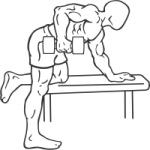 Holding a dumbbell in one hand, bent over so your upper body is near-parallel with the floor and rest your hand on a bench or rack. Bend your knees and lower the dumbbell to a stretched position, but keep your upper and lower back rigid (ie., not twisted). Raise the dumbbell to your stomach then lower it back to the stretched position without resting.
Holding a dumbbell in one hand, bent over so your upper body is near-parallel with the floor and rest your hand on a bench or rack. Bend your knees and lower the dumbbell to a stretched position, but keep your upper and lower back rigid (ie., not twisted). Raise the dumbbell to your stomach then lower it back to the stretched position without resting.
Bent Over Rows:
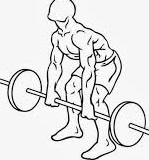 There’s plenty of debate on how to do bent over rows. Basically, you want to work your upper and mid back and not heave the weight up using your glutes and lower back. Do them Pendlay-style (how to) or the traditional bodybuilding way (how to). Bend your legs slightly and raise the bar to any point on your stomach that feels comfortable.
There’s plenty of debate on how to do bent over rows. Basically, you want to work your upper and mid back and not heave the weight up using your glutes and lower back. Do them Pendlay-style (how to) or the traditional bodybuilding way (how to). Bend your legs slightly and raise the bar to any point on your stomach that feels comfortable.
T-Bars:
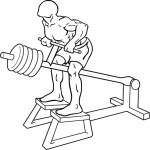 Hop up on the T-bar platform and grab the handles. Raise up until your upper body is at approximately a 30 degree angle to the platform and bend your legs. Start from the bottom and lift until the plates touch your lower chest. It’s natural to allow for the lower back to come into play a bit, because of the fixed range of motion, just don’t get too crazy. Don’t rest at the top or bottom of the movement.
Hop up on the T-bar platform and grab the handles. Raise up until your upper body is at approximately a 30 degree angle to the platform and bend your legs. Start from the bottom and lift until the plates touch your lower chest. It’s natural to allow for the lower back to come into play a bit, because of the fixed range of motion, just don’t get too crazy. Don’t rest at the top or bottom of the movement.
Rinse and Repeat
That’s round one of the auxiliary workout! Take a rest day (or two, if needed), then work each major body part again as you normally would for 3 days, rinse and repeat. Be sure to mix in cardio in the picture as your heart is an important muscle as well. You’ll find that you hurt in places you may have never felt before after the first few times you do each workout. If you find you’re excessively sore, don’t attempt to lift heavy on your non-auxiliary muscle workouts until your supporting muscles and tendons are able to catch up.
Good luck and happy building!

